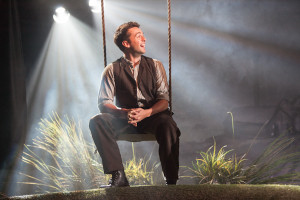A figure, clad in long dark cape makes its way across a dimly lit stage… and suddenly vanishes leaving only and empty cape and the screams of delight of the young audience behind.
This is Theatr Na nOg’s re-staging of their original 2008 production ‘The Ghost of Morfa Colliery’.
Set in Taibach, Port Talbot at the end of the 19th century this play tells the story of the pit explosion that killed 87 miners. On March 10th 1890, 450 men should have been at work but something kept 200 of them at home, and their lives were saved while others perished. In the inquest, there were accounts of ghostly apparitions and unearthly voices heard weeks before the explosion.
The technical elements of the production are superb, with an imaginative and highly detailed set created on two levels by Kitty Callister, atmospheric lighting design by Eleanor Higgins and spooky soundscape by Gareth Brierley, all of which give a springboard for the imaginations of the young audience, to become fully immersed in the Victorian world of the play.
Throughout the performance the greatest squeals of delight and, in the production I attended, most of the questions in the Q&A session at the end of the performance, come from the imaginative use of illusion. In the mine Davy Lamps float mysteriously and in the kitchen stools move by themselves. Throughout the performance the cast appear and disappear unexpectedly as if by magic, which indeed it is, as Theatr na nÓg have collaborated on this performance with Derren Brown’s right hand man James Went. His illusions are used to great effect throughout the performance, really adding an extra dimension to the production.
The cast of four handle the nine characters in the text ably. Jack Quick playing Bethnel Haycock portrays a youthful exuberance which is often difficult to capture; and Rees Oates, the ‘tall and wide’ friend of Bethnel, played by Aled Herbert is simplistic and lovable, but often lacks the variety in delivery which would make the character particularly stand out. That being said, at times the friendship between them is sincerely touching.
Tonya Smith as Mrs. Haycock has some beautiful moments of emotion, but often misses moments of sincere connection between her character and son Bethnel which would really enhance the impact of the story.
Particular praise should be given to Richard Nichols who plays 4 characters, each differentiated with a great deal of flair.
The cast really shines in the moments where they are allowed to caricature some of the smaller roles. This is particularly evident (and hilariously funny) in a scene which takes place in the chapel: Aled Herbert in drag to play Mrs Williams, Tonya Smith as Mrs Francis and Richard Nichols as John Francis, with the recorded voice of the minister raising at moments when their conversation interrupts the sermon. Their facial reactions are priceless!
The direction of the piece by Theatr na nÓg’s Artistic Director is effective, however, the pacing of the piece on occasion spoils the impact, with times of stillness often squandered and the feeling of pushing to the end often steamrollering what could be some stand out moments.
The same goes for the volume. The Dylan Thomas Theatre is not a large space, and, as such there is the opportunity for the cast to vary delivery- not to have to belt out each line. This is particularly noticeable when Tonya Smith as Mrs. Haycock, reads from her her son, Bethnel’s diary, supposedly in secret, yet in fact at full belting volume which would bring everyone, no matter how far down the mine they might be, rushing to find out what was being said!
The writing by Geinor Styles (Director) & Mali Tudno Jones is of a good quality, if at times slightly presentational, with a strong sense of story and humour mixed in with the terror – as a good ghost story should be. Overall this is a good piece of theatre for a young audience.
This entire 10 week run is fully booked by school groups, however I for one am certainly looking forward to future productions by Theatr na nÓg.
